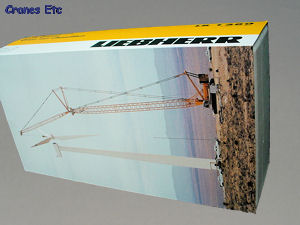 | | The box. |  | 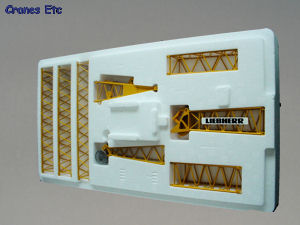 | | Tray with boom and jib sections. | 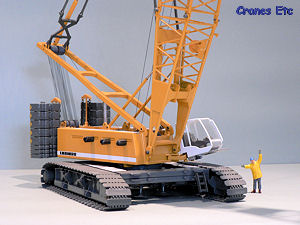 | | View with the winch handles in place - they can be removed. | 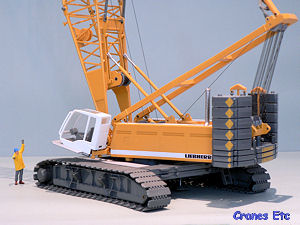 | | Impressive side-on view. | 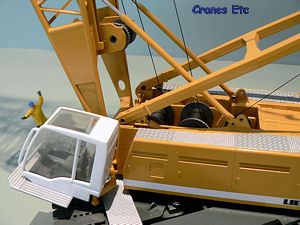 | | Cab and winches. | 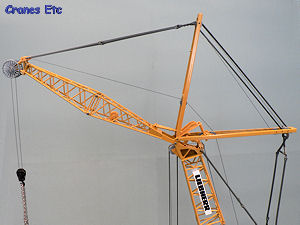 | | Luffing fly jib in a short configuration. | 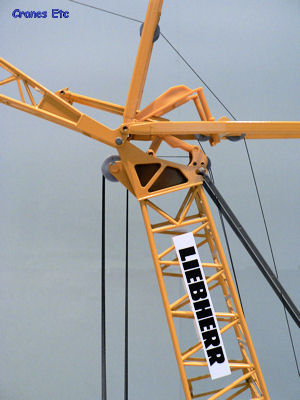 | | Detail at the boom head. |
| The LR1280 crawler crane was the largest Liebherr crawler crane model when it first appeared at the end of 2002 and represented a step change increase in size from the previous largest Conrad model of this type, the Sennebogen Starlifter 5500.
Packaging
The model is packed in a very large box consisting of a three piece polystyrene set (two trays and a lid) kept together with a sleeve which has a picture in the normal Liebherr style. The model is securely packed and arrived without damage. Very good instructions are provided over four pages which include a parts list shown by pictures. The quality of the instructions means that you do not need to be a crane expert to assemble this model.
Detail
The crawler tracks are each a separate unit consisting of a detailed frame with sprockets, and tracks made up of detailed plastic links. The cross-frame supporting the crane is pinned to the track frames and includes screw jacks to support the body whilst the track frames are being fitted. Each side of the cross frame has a pair of ballast plates which span from track to track and add additional weight. To complete the under frame, walkway planks are fitted next to each track and a ladder clips into each pair of ballast plates.
Moving to the main body of the crane, detailing is good with cast in details for grilles on the sides, walkway plates on the top and an exhaust pipe and other details. The cab is fitted on a hinge mechanism and looks effective with walkway and grab rail. Internally the cab detail is moulded to indicate a monitor, controls and pedals.
The counterweights are excellent pieces with cast-in lifting lugs and very good decals. The counterweight self-assembly is modelled well with cylinders and lifting chains provided.
The A frame is fixed permanently to the top of the body and also has a self-erection cylinder with a hook. The plastic pulleys fitted to this part and the rest of the crane are better quality and more free-rolling than previous models. The boom and jib sections are excellent throughout. They are joined by the plastic pins preferred by Conrad and this is an effective system which gives confidence when lifting a big arrangement where the stresses are high. The sections at the top and bottom of the main boom are complex structures and are made very well. The mechanical arrangement at the base of the luffing jib works well although some of the plastic parts in this area are a little delicate. At the tip of the luffing jib a pair of plastic dolly wheels are provided to enable the jib to drag along the ground during erection. The pendant bars supporting the boom and jib are plastic and these work well although would be better as metal components. The equalisers fitted to the end of each pair of pendant bars are modelled, but they are solid pieces so they do not actually function and equalise the tension in pendant bars that are not exactly the same length.
Two hooks are provided. A standard metal single pulley hook suits the luffing jib but Conrad has provided a proper hook for the main boom. This is a large heavy piece with six pulleys and a double hook. It suits the size of the crane very well.
Features
The first excellent feature is that the model splits down into pieces for transportation so it can be displayed on an appropriate set of heavy haulage. Secondly, as the self-erection hydraulic cylinder is also modelled it can also be displayed in a variety of ways through the stages of erection, and this is enhanced further by the lifting jacks on the main cross frame. Thirdly, there are all of the various combinations from a short main boom up to full main boom and luffing jib. As a model for display it offers a huge variety of options which can be changed over time.
The tracks work extremely well. Pushing the model on a smooth surface causes the tracks to roll without any slippage. All the main crane functions can be operated including a total of four hoist drums, one each for the boom and jib, and one for each hook. Three of the winches are operated by means of turning handles, which on this model are made of metal. They are also removable so the look of the model does not have to be compromised when posed. The fourth winch, fitted at the base of the main boom, controls the luffing fly jib and is operated by finger directly on the serrated edge of the drum.
The cab moves into position between transport and operating mode and tilts for those high up lifts. The dolly wheels at the end of the luffing fly jib allow the erection of the jib to be simulated well.
The weight of the model, assisted by the ballast plates between the tracks, mean that the model is very stable except at the very extremes of operation.
Quality
By any standards this is a very good model indeed. The quality of the manufacture is very high with the review model assembling perfectly. Casting quality is excellent and this is matched by the paintwork and lettering. Although the tracks are plastic they roll very well and look very good also. The pulleys are plastic but they are markedly better than previous models. Also the large hook supplied is a welcome improvement in an area where Conrad cranes have been a little weak in the past.
Price
The LR1280 is relatively costly compared to other mass-produced models of this scale, but fully justifies its price in terms of the detail, quality and size that is offered.
Overall
A superior model which is of a size which will impress the non-collector. With the addition of the separate additional jib sections the LR1280 enters the mega-model class for size. Although it could be further improved by, for example, having metal tracks and pendant bars, this does not detract from what is currently offered.
Footnotes
The model went on sale at the end of 2002, and was first publicly displayed at the Nuremberg Toy Fair in 2003. At the end of 2003 a limited run was produced in Sarens colours (blue body and yellow tracks). An additional jib extension kit is available (model number 98006). It consists of one main boom section and one luffing jib section and the associated pendants. Three kits take the crane to its maximum rigged height. In April 2008 a version in Mammoet colours appeared in a run of 1000 models.
|
| |
| 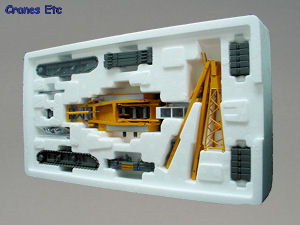 | | Tray with the body, tracks and ballast weights. | 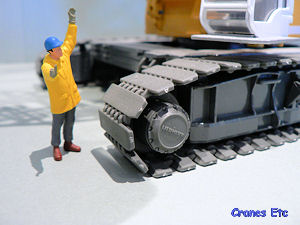 | | Although the tracks are plastic they look very good. | 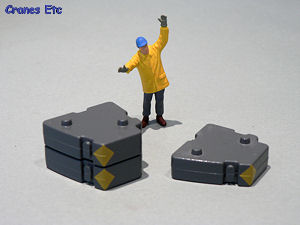 | | Ballast weights are very good separate pieces with lifting lugs. | 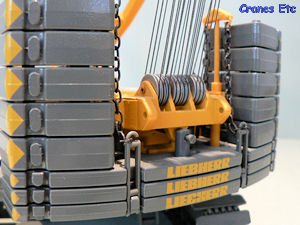 | | Counterweight slabs are lifted into place by chains connected to hydraulic cylinders. This is modelled very well on the LR1280. | 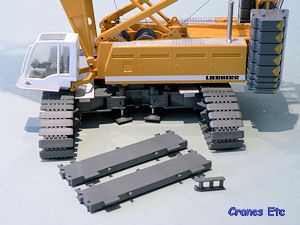 | | The ballast slabs between the tracks are separate pieces. When removed, the jacks for lifting the body can be seen. | 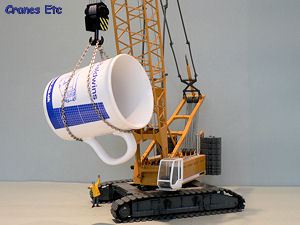 | | Lifting a 'vessel'. | 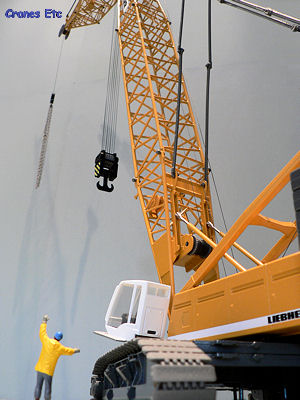 | | It looks very good from all angles. |
|

